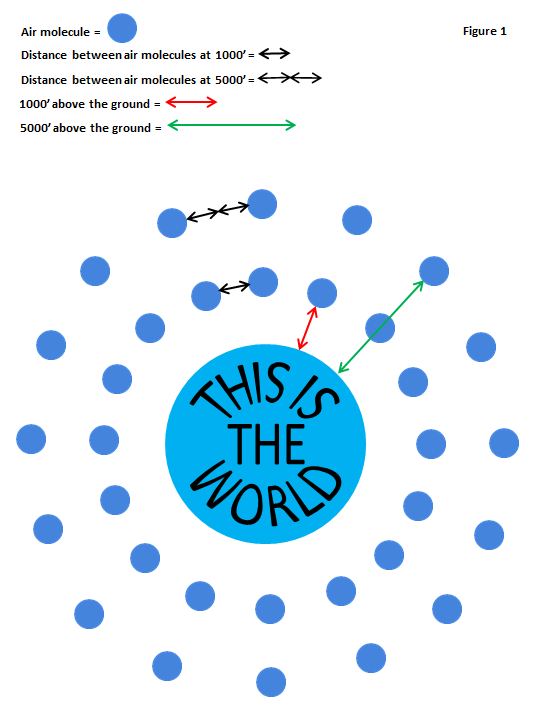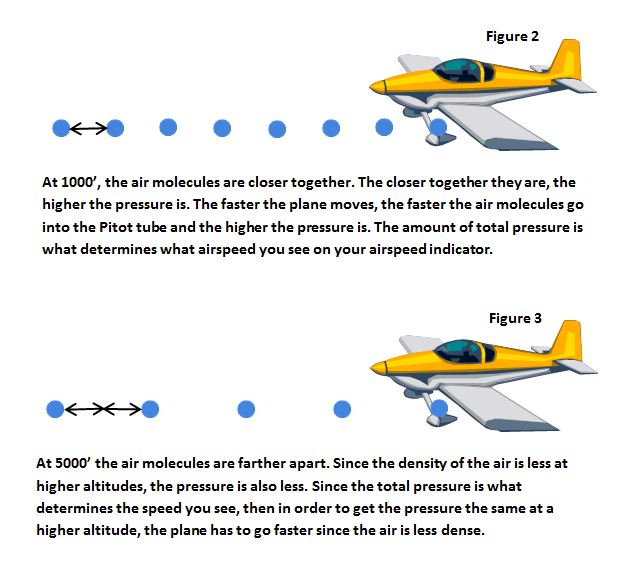When you hear the term “high density altitude”, do you get confused as to what that means? Most people do, so don’t worry! We’re going to clear it up once and for all and talk about how it affects you. Before we start, I’d like to clarify something. The images below are not to scale nor do they represent how close the molecules are to each other or the way they are laid out exactly in relation to the earth or each other. They are positioned this way for you to easily visualize how the density of the air changes with altitude and to better understand how it affects performance. It does not talk about how the air is compressed and becomes more dense, it simply shows that the air is less dense as you go higher.
When you hear “high density altitude”, it does NOT mean that the air is dense (thick) like most people think. You can’t just look at the words “high and density”, that of course would mean the air is dense. You need to look at the whole thing. When you hear the words “high density altitude”, it’s referring to the density of the air at a higher altitude.
For example, your home town airport has an elevation of 1000′ above sea level. You tune in the automated weather station and you hear it say that the density altitude is 3000′. That is a high density altitude because it’s higher than the field elevation at your airport. It is saying that the density (amount or thickness) of the air at your airport is equal to what it would be at 3000′. I will explain more in a minute with a diagram.
So what does the air density do as you go higher? If you don’t remember, think of going so high that you are in space. What is the density of the air there? The air density is much less. To make that even easier to understand, don’t think of all the empty space around you as air. Think of air as a bunch of balls (molecules). The amount of balls (molecules) there are determines the density of the air (molecules). If I fill a box with the balls (air molecules), it is dense with air. If I take a box that is twice the size and dump the balls from the smaller box into it, I have the same amount of balls (air molecules) in it but since they are not filling the box now, it is no longer dense with air.
This is the same concept you need to think of as you fly higher. People think that as you go higher, there is less air. That is not true. Think of the box scenario. As you go higher, you still have the same amount of air, but the air isn’t as dense (tightly packed together). Look at the diagram below and notice how there is the same amount of air molecules at a higher altitude, but they are farther apart from each other.
 Notice how as you go higher, the air is less dense (packed together), but the same amount of air molecules is still there. So how does this affect you? The airplane needs air to fly. When you’re taking off, you have to get to the right speed before there is enough air (molecules of air) traveling over and under the wing to support lift.
Notice how as you go higher, the air is less dense (packed together), but the same amount of air molecules is still there. So how does this affect you? The airplane needs air to fly. When you’re taking off, you have to get to the right speed before there is enough air (molecules of air) traveling over and under the wing to support lift.
The airspeed works the same way. As you accelerate down the runway, the balls (air molecules) are going into the pitot tube faster and faster and the pressure is increasing. The total pressure is what gives you your airspeed reading. Look at figures 2 and 3 below and to see how the density of the air at different altitudes affects performance.
So, let’s look at the above example in a take off situation. In figure 2 above, lets assume that our field elevation is 1000′. When the balls (air molecules) start entering the pitot tube and the pressure increases enough to indicate whatever your lift off speed is, then you’re ready to fly.
In figure 3 above, your field elevation is 5000′. Since we know the air is less dense (air molecules are farther apart) at higher altitudes, we know that we have a farther distance to travel to get to the next molecule of air. If we have farther to travel but we need the same amount of pressure to give us the required lift off speed, then we will have to go faster to do so. To go faster takes more time. More time traveling means more runway being used. This is the reason it takes more runway distance to take off at a high elevation airport. The same applies for landing. To keep the speed indicating properly when landing at a high elevation airport, you need to be traveling faster. Even though the speed is indicating the same, you will be flying much faster over the ground and using up more runway in the process.
The last part of this article, is heat. Heat affects the plane the same way high altitude does. As it gets hotter outside, the air becomes less dense. As the air becomes less dense, the plane will use more runway to get to flying speed just as if it were at a high elevation airport. When you hear the automated weather say that the density altitude is at 5000′ for example, that means your plane will perform as if you were flying at an elevation of 5000′.
High density altitude, high airport elevation and heat all mean more runway, slower acceleration and and worse performance. Always be sure to check your performance chart so you know how much runway and what kind of climb rate you will get before taking off. You want to be sure the runway is long enough and that you will clear the obstacles at the end! Sign up for our free newsletter for more information about how this can affect you and for other tips, advice and recommendations sent to your email.


I just got up from nap and I am already reading your articles. This signifies something! Really useful info. Thnx!
Density altitude of 5000 means when your plane is at ground level, it will perform as if you were already at an elevation of 5000′.
Correct